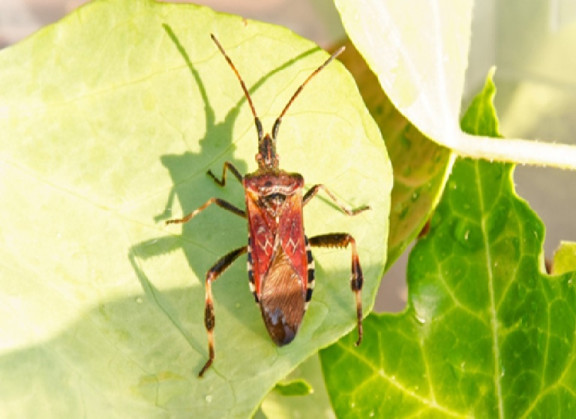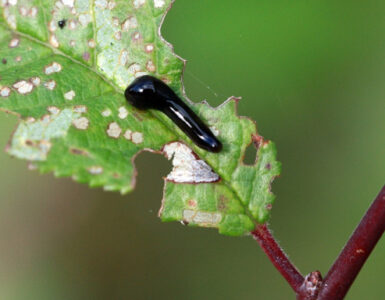Western conifer seed bugs are often confused with stink bugs because they look alike. They can be annoying, especially when they invade homes in search of warmth.
While these bugs are harmless to humans, their presence can be bothersome.
Fortunately, there are natural methods to keep them at bay and remove them from your home and garden.
Identification
These bugs are insects that primarily feed on the seeds and cones of coniferous trees [1].
They are known for their distinctive odor when disturbed, often likened to pine.
Additionally, Western conifer seed bugs (pine seed bugs) are about ¾ to 1 inch long.
They are reddish-brown, with a flattened, shield-shaped body. Their hind legs are notably wider and flattened, with a leaf-like appearance.
These bugs also have long antennae and may be mistaken for other similar-looking insects, such as stink bugs, but they are harmless.
How to Get Rid of Western Conifer Seed Bugs Naturally
Here’s a guide on natural ways to manage and get rid of these bugs. These are mainly home remedies that you can employ yourself.
1. Vacuum Them Up
One of the easiest and most effective ways to get rid of Western conifer seed bugs in your home is to vacuum them up.
Use a vacuum cleaner to suck up the bugs when you spot them.
Be sure to empty the vacuum bag or canister immediately after to prevent any lingering odors from the bugs.
2. Natural Predators
Encouraging natural predators to come around can help control western conifer seed bug populations.
Birds, spiders, and predatory insects such as assassin bugs and some tachinid flies can all help keep these bugs in check [2].
Creating an environment that attracts these predators can naturally reduce the number of seed bugs.
3. Remove Them by Hand
If you encounter these bugs in small numbers, you can remove them by hand.
However, put on some disposable gloves to avoid contact with their odor. Next, gently pick the bugs up and place them in a container with soapy water.
This method is adequate for small infestations.
4. Diatomaceous Earth
Sprinkling diatomaceous earth (DE) in areas where you’ve seen the bugs can also help control them.
The powder works by damaging their exoskeletons, causing them to dehydrate and die.
Therefore, sprinkle a thin layer of DE around entry points and any areas where you’ve seen seed bugs. It will kill them not long after they crawl through it.
5. Keep Your Yard Free of Debris and Clutter
These insects often seek shelter in rodent nests, under conifer bark, or in other debris.
So, keeping your yard free of clutter can minimize hiding spots for the bugs. It will also reduce the risk of them entering your home.
6. Essential Oils
Certain essential oils are known to repel insects, including stink bugs and seed bugs. Peppermint, lavender, and lemongrass oils are particularly effective.
You can create a natural bug repellent by mixing 15 drops of one of these oils with 4 ounces of water in a spray bottle.
Spray this home remedy around entry points and on any surfaces where you’ve seen the bugs.
The strong scent of this homemade Western conifer seed bug spray will deter them from entering your home.
7. Remove Attractants
These bugs are attracted to conifer trees, especially in the fall, when they seek out seeds to feed on.
If you have conifers near your home, consider reducing their number. You can also trim them back to create some distance between the trees and your house.
Also, keep your yard free of fallen pine cones and debris, as these can attract conifer seed bugs.
8. Maintain a Clean Home
Keeping your home clean and clutter-free can also help reduce the likelihood of a Western conifer seed bug infestation.
Regularly dusting and vacuuming can remove any bugs that have entered your home, along with their eggs.
Also, pay special attention to windowsills, door frames, and other areas where the bugs may hide.
9. Sticky Traps
Sticky traps are another practical method for controlling western conifer seed bugs.
Place these traps near windows, doors, or other areas where the bugs are likely to enter.
The bugs will get stuck to the adhesive surface, making them easier to remove from your home.
10. Seal Gaps and Any Openings to Your House
Seal gaps, cracks, or openings around windows, doors, and foundations. This will help keep western conifer seed bugs out of your home.
Also, check for any openings around utility lines, vents, and chimneys, and seal them.
Takeaway
Western conifer seed bugs are not really a threat. However, they can still be bothersome, especially when they enter your home.
Using these natural methods, you can lower their numbers and keep them from being unwanted house guests.
Remember, persistence is key, and combining several of these home remedies will yield the best results.








Add comment